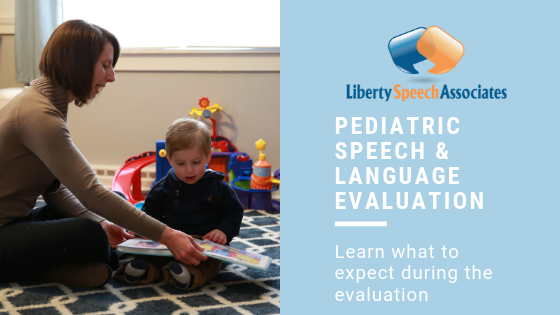Although all speech-language pathologists structure their evaluations a little differently, there are crucial components that should be expected as part of all pediatric speech and language evaluations. These components include a family interview, an oral mechanism examination, assessment of articulation/phonology, assessment of voice, assessment of fluency, assessment of receptive and expressive language, and a discussion of the results. Depending on your child’s age, his reported difficulties, and/or the location of the evaluation, additional components of the evaluation may include: a teacher interview, a hearing screening, a play assessment, a feeding/swallowing assessment, and/or a narrative assessment. Each of the crucial components will be described in detail below:
Family Interview
The purpose of the family interview is to gather information about your child’s background, such as birth and medical history, speech and language concerns, past evaluations and/or therapies, developmental milestones, languages your child speaks and/or hears.
Oral Mechanism Examination
The purpose of an oral mechanism examination is to assess the structure and function of your child’s oral mechanism (e.g., lips, tongue, teeth, hard/soft palate) to support speech and/or feeding. Examples of tasks your child may be asked to do during this portion of the evaluation include moving his tongue from side-to-side, opening his mouth and saying “ah,” and raising his tongue to try and reach his nose.
Assessment of Articulation/Phonology
Articulation refers to the way we produce sounds using our oral mechanism and phonology refers to the way we organize sounds to form words. The purpose of assessing articulation and phonology is to observe what sounds your child can say, as well as to determine if your child has any errors in his speech and if there are patterns to those errors. For young children (under the age of 3), assessment of articulation and phonology is primarily done through a speech sample obtained during various play activities. A speech sample is exactly how it sounds – it is a sample of your child’s naturally occurring speech. For older children (above 3), assessment of articulation and phonology typically includes analysis of a speech sample obtained through conversation and/or play, as well as administration of a standardized test. During the standardized test, your child will look at pictures and/or objects, which represent all of the consonants (and depending on the test, also vowels) in Standard American English, and be asked to name them. The evaluator will transcribe what your child says for analysis.
Assessment of Voice
Voice refers to the quality, loudness, pitch, resonance and prosody of one’s speech. For most pediatric evaluations, especially for young children or when vocal characteristics are not a concern, assessment is done through a speech sample. The evaluator listens to your child’s speech to see if it appears appropriate for his age or gender. However, for older children and/or for those with vocal concerns, assessment may include a discussion of how your child is using his voice and his feelings about his voice, use of computerized software to analyze your child’s speech compared to same-age children, and/or laryngeal imaging.
Assessment of Fluency
Fluency refers to fluidity of one’s speech. The purpose of a fluency assessment is to determine if your child experiences stuttering and/or cluttering. For young children, assessment of fluency focuses on obtaining a speech sample to analyze any disruptions in the flow of your child’s speech. For older children with fluency concerns, assessment involves obtaining a speech sample, as well as discussing feelings about the fluency difficulties and situations when fluency skills are better/worse and administering a standardized fluency test. During the standardized test, your child may be asked a series of conversational questions, instructed to read different passages, and/or asked to describe various picture scenes.
Assessment of Receptive/Expressive Language
The purpose of a language assessment is to determine your child’s ability to understand and use language for a variety of purposes. Assessment of language includes obtaining a language sample, as well as administering standardized tests. The tasks your child is asked to do would depending on the test(s) administered; however, like with most standardized tests, your child is likely to be asked questions about different pictures, objects, and stories. For example, he may be asked to find a picture described by the evaluator (e.g., show me the big black dog).
Discussion of the Results
At the conclusion of the evaluation, there should be a discussion of results with the evaluating speech-language pathologist. The speech-language pathologist should share her findings (diagnoses, observations), inform you if additional testing by a speech-language pathologist or related professional is recommended or required, discuss if speech/language therapy is warranted, and answer any questions you may have.

